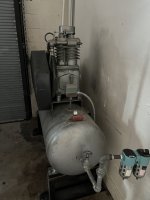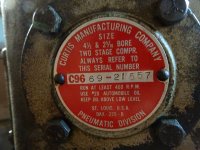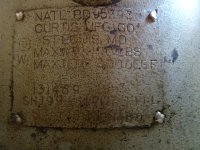To get the approximate volume of the tank, it is a simple matter of grade-school mathematics. Namely: measure the diameter and length of the tank. If you cannot get a good diameter reading, 'strap' the tank with a piece of twine (or a flexible tape measure). This will give you the circumference. Divide the circumference by Pi (3.14159) and you have the diameter.
To get the volume: divide the diameter by 2 to get the radius. Square the radius and multiply by Pi. This is the area of the tank's cross section, in square inches.
Multiply this by the length of the tank and you have the approximate volume (the dished end heads are a bit trickier to calculate the volume for). This will give you the approximate volume in cubic inches. Divide this number by 1728 and you have the tank volume in cubic feet. Divide this number again by 0.133 and you have the volume of the tank expressed in gallons.
CFM delivered by the compressor is where it all originates. You have a two-stage compressor from your photos. Knowing the bore and stroke and rpm of the compressor will give you a starting point to get the cfm. The cfm of 'free air' (air at atmospheric pressure) the compressor takes in vs the cfm of air compressed to some higher pressure are two different quantities. A two stage compressor is designed to deliver air at a higher pressure, and will have a lower cfm output than a twin cylinder single stage compressor. Motor horsepower and rpm of the compressor are good approximate indicators of the delivery rate (cfm) the compressor will put out.
CFM from the air receiver (tank) is another matter.The delivery from a receiver (cfm) can be a great deal higher than the compressor puts into the tank, but for a fairly short duration. It is a question of what the use/air consumption/time duration vs receiver size. A larger receiver can supply a lot more cfm the the compressor that charges it up, but for a short duration. Example would be running air tools such as larger air grinders which consume a lot of compressed air. If the use is only for short bursts, the receiver can run the air grinder, and there is time for the compressor to 'catch up'. However, if the air grinder (or other high flow usage) is to be continuous, then the compressor has to be sized to keep up.
You do not say what the air usage is going to be, so impossible to say if the compressor and receiver will be able to keep up with demand. Other point: we have had a number of threads here about the potential dangers with older/used compressed air receiver tanks. 1958 on the ASME tag on the tank means the tank is quite old (over 60 years). Compressed air contains moisture, and this forms condensation in the bottom of air receiver tanks. Even with regular blowdowns to drain the condensate, corrosion in steel air receiver tanks is inevitable at the bottom of the receiver. I worked in a powerplant where we quite a few compressed air receivers, some as big as 2400 gallons. Each year the insurance risk avoidance engineers would arrive and have some new horror story about an air receiver tank exploding without warning. Compressed air is, as its name says, 'compressible'. When a tank ruptures, the air expands violently back down to atmospheric pressure. The result is compressed air tank failures often result in the tank 'unzipping' from a thinned area and often the tank launches itself like a rocket, or shoots chunks of shrapnel, and has enough energy to do damage to the building it is in (and anyone near to it). In industry, a tank on a garage type air compressor that is 60 years old would be removed from service and cut up to prevent re-use. It is considered cheaper to replace this type of air receiver than to test it or take a chance on it.
If you and your employer want to use the Curtis compressor with the 1958 air receiver, you should do the following before putting it into use:
1. Do an ultrasonic thickness gauging of the receiver, all over it, the end heads and the barrel. Plat the receiver into a grid using a paint marker, squares about 4" x 4".
Take UT readings in the corners and center of each square. You will wind up with a LOT of readings.
2. Look at the ASME code data plate on the receiver. This will give original thicknesses of the barrel (shell) and end heads. Compare the lowest UT readings on the
barrel and end heads with the original thicknesses on the data plate. Chances are the readings at the bottom of the tank barrel will be a bit thinner than
original.
3. Run a set of calculations to determine Minimum Required Thickness of the barrel and end heads for whatever working pressure you want to hold in the tank.
Base the calculations on: assumed tensile strength of pressure-vessel grade steel = 50,000 psi, factor of safety = 4.0, so maximum tensile stress allowed in
the barrel and end heads = 12,500 psi.
4. If the tank passes U/T and calculations show it will be adequate for the maximum allowable working pressure (MAWP) with a Factor of Safety = 4,
(and you may wind up dropping the MAWP a bit), then you move to a hydrostatic pressure test of the tank. This, as the name says, is done with WATER.
You remove the pressure switch, safety valve, and other appurtances and plug them off. Fill the tank with water, bleed off the air at the high point, and pressurize
to 1.25 x MAWP. As you some up to test pressure, you inspect the tank for bulges or leaks that may appear as 'little pissers'. Those little pissers during a water
hydro test could turn into a tank ripping itself apart if pressurized with air.
5. If the tank passes hydro, and no deformation or leaks are seen, you can then put it into service. However, it is on you and whomever owns/operates that
compressor to be aware of the dangers inherent in old/unknown air receivers. They are potential bombs. Best advice, cut it up and get a new air receiver.
Too much risk of having that old receiver blow itself to bits and take out anything and anyone nearby. Air receivers do not 'spring a leak' like a water tank.
A buddy has an automotive repair garage. His neighbor had bought some el-cheapo compressor mounted on an air receiver at a yard sale. Getting it home,
the neighbor discovered the air receiver had a 'pinhole' leak. My buddy with the garage warned the neighbor that this was a real bomb. Neighbor said he'd be
using the compressor outdoors. A few days later, my buddy was working in his shop when he heard a hell of a bang followed by a thud. It was the neighbor's
air receiver blowing itself apart. The thud was when it landed on the roof of the neighbor's house. He was quite fortunate as the tank blew itself straight up
and ripped apart at the bottom. No shrapnel launched. Word to the wise....









